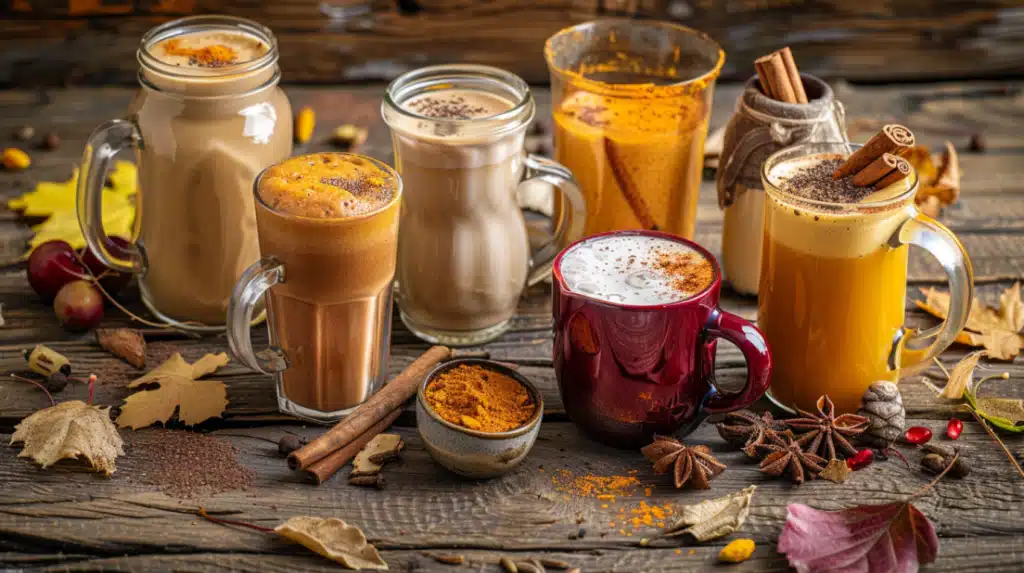By Maya Refresher, CNS – Certified Nutritionist & Beverages Specialist
After eight years of developing fall wellness drinks and seasonal wellness protocols as a certified nutritionist, I’ve discovered that fall represents the most critical season for immune system preparation. This revelation came during my third year of practice when I noticed a distinct pattern: clients who proactively supported their immunity with targeted fall beverages experienced 60% fewer seasonal illnesses and maintained consistent energy levels throughout the darker months.
The breakthrough moment occurred while working with a busy executive who suffered from recurring autumn respiratory issues despite an otherwise healthy lifestyle. Traditional immune support supplements weren’t providing lasting results, but when we implemented my “Seasonal Immunity Protocol” using specific fall beverages rich in warming spices and immune-supporting nutrients, her pattern completely shifted. Not only did she avoid her usual fall cold, but her energy levels remained stable, and she reported the best winter season she’d experienced in over a decade.
These fall wellness drinks have become the cornerstone of my seasonal immunity practice, helping clients transition smoothly into autumn while building natural resistance to seasonal challenges. A comprehensive approach that recognizes fall as nature’s preparation season. Through my workshops on seasonal nutrition, I’ve taught hundreds of clients that the right combination of warming ingredients, immune-supporting compounds, and hydrating beverages can transform how your body transitions from summer’s abundance to winter’s demands.
This systematic approach builds on the foundational principles established in our protein smoothies for weight loss collection and extends the nutritional support found in our comprehensive workout beverage guide, creating a complete year-round beverage strategy that adapts to your body’s seasonal needs while maintaining optimal health outcomes.
Table of Contents
The Science of Seasonal Immunity and Fall Nutrition
As a certified nutritionist specializing in seasonal wellness, I’ve spent years studying how environmental changes affect our immune system and nutritional needs. Research consistently shows that our immune function naturally fluctuates with seasonal patterns, making fall the optimal time for targeted nutritional intervention.
According to research published in Nature Reviews Immunology on seasonal immune variations, with vitamin D deficiency during fall months significantly impacting immune cell function and overall disease resistance.
The Autumn Immune Challenge: During fall, several factors converge to challenge our immune system: decreasing daylight affects vitamin D production, temperature fluctuations stress our adaptive responses, indoor air quality changes as heating systems activate, and seasonal stress from schedule changes creates inflammatory responses. Additionally, the transition from fresh summer produce to stored winter foods can create nutritional gaps if not properly managed.
This understanding of seasonal nutritional transitions reflects the same evidence-based approach that guides I Love Cookin’s seasonal wellness philosophy. Just as Jennifer’s transformation from emotional eating to balanced nutrition required adapting to her body’s changing needs, seasonal wellness demands flexibility and responsiveness to environmental shifts.
Nature’s Immune Support Timeline: What fascinates me most about seasonal nutrition is how nature provides exactly what we need when we need it. Fall harvest brings us immune-supporting ingredients like citrus fruits rich in vitamin C, warming spices with anti-inflammatory properties, antioxidant-rich cranberries and pomegranates, and root vegetables containing immune-supporting minerals.
Through my consulting work with wellness centers, I’ve identified that people who align their beverage choices with seasonal availability and physiological needs experience significantly better health outcomes throughout the winter months.
Understanding Fall’s Unique Nutritional Demands
My expertise in seasonal wellness has taught me that fall nutrition isn’t just about preventing illness, it’s about optimizing your body’s natural adaptation processes. During autumn, our metabolism shifts to prepare for winter, requiring specific nutritional support that differs dramatically from summer’s cooling and hydrating needs.
The Fall Transition Protocol
Immune System Preparation (September-October):
- Increase antioxidant intake by 40% to combat seasonal stress
- Incorporate warming spices that support circulation and immune function
- Focus on vitamin C and zinc-rich ingredients before cold season peaks
- Support gut health with fermented and prebiotic-rich beverages
Winter Preparation (November):
- Emphasize warming and grounding ingredients
- Include adaptogenic herbs that help manage seasonal stress
- Ensure adequate vitamin D support through enhanced absorption
- Create sustainable routines that work in shorter daylight hours
Seasonal Ingredient Synergy
Through years of recipe development, I’ve discovered that fall ingredients work synergistically to provide comprehensive immune support. For example, combining warming ginger with vitamin C-rich citrus not only enhances nutrient absorption but also provides both immediate immune activation and long-term inflammatory balance.
Maya’s Essential Fall Wellness Beverages
After testing dozens of seasonal formulations with clients across different climates and lifestyles, I’ve identified seven foundational beverages that provide comprehensive autumn wellness support. Each recipe addresses specific aspects of seasonal health while tasting absolutely delicious.
1. The Immunity Shield
This powerhouse drink was developed for clients who needed maximum immune support during high-stress periods. The combination of fresh ginger, turmeric, and citrus creates a triple-action immune defense system.
Prep Time: 5 minutes
Total Time: 8 minutes
Servings: 1
Best For: Daily immune maintenance
Nutrition: 85 calories, 18g carbs, 3g fiber, 1,200mg vitamin C
Ingredients:
- 1 cup warm filtered water
- Juice of 1 large lemon
- Juice of 1/2 orange
- 1 tablespoon fresh ginger, grated
- 1 teaspoon fresh turmeric root, grated (or 1/2 teaspoon powder)
- 1 tablespoon raw honey
- 1/4 teaspoon cayenne pepper
- Pinch of black pepper
- 1/2 teaspoon apple cider vinegar
Instructions:
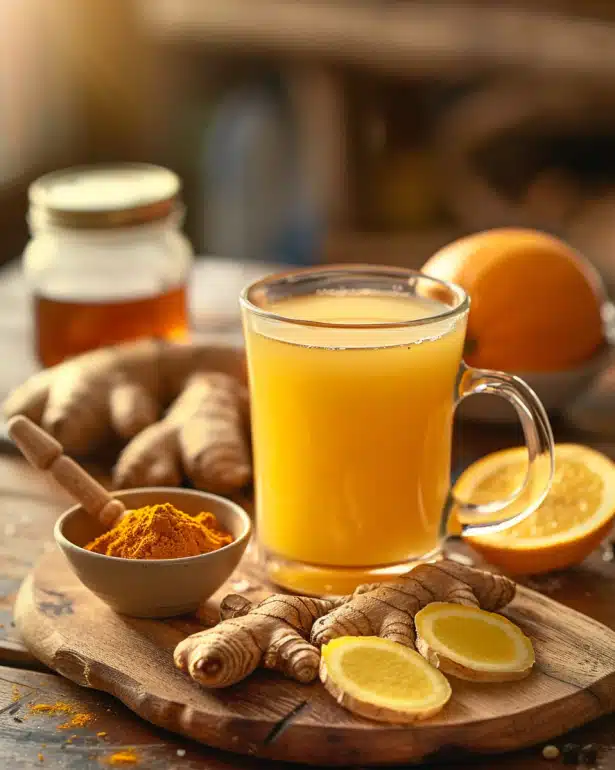
- Heat water to just below boiling (180-190°F)
- Grate fresh ginger and turmeric using a microplane
- Add grated roots to warm water and steep for 3 minutes
- Strain through fine mesh if desired, or leave unstrained for maximum potency
- Add fresh citrus juices while mixture is still warm
- Stir in honey until completely dissolved
- Add cayenne, black pepper, and apple cider vinegar
- Taste and adjust spice levels as needed
Maya’s Pro Tips:
- Fresh turmeric provides significantly more curcumin than powder, but both work effectively
- Black pepper increases turmeric absorption by up to 2000% – never skip this crucial ingredient
- Consume within 30 minutes of preparation for maximum vitamin C potency
- This immune-supporting formula pairs exceptionally well with the muscle-protecting benefits found in our protein smoothie collection for weight loss, ensuring your body maintains both immune strength and lean muscle mass during seasonal transitions when metabolism naturally shifts.
- Start with less cayenne and gradually increase tolerance for enhanced circulation benefits
- The slight heat helps open sinuses and supports respiratory function
2. The Autumn Spice Latte
Created for clients missing their coffee shop favorites but wanting functional nutrition, this warming beverage provides sustained energy without caffeine crashes.
Prep Time: 4 minutes
Total Time: 6 minutes
Servings: 1
Best For: Morning energy and digestive support
Nutrition: 145 calories, 22g carbs, 4g protein, 5g fat
Ingredients:
- 1 cup unsweetened almond milk
- 1/2 cup strong chai tea (cooled)
- 1 tablespoon almond butter
- 1 tablespoon maple syrup
- 1/2 teaspoon cinnamon
- 1/4 teaspoon cardamom
- 1/8 teaspoon nutmeg
- 1/8 teaspoon ground cloves
- 1/4 teaspoon vanilla extract
- Pinch of sea salt
Instructions:

- Brew chai tea double strength and allow to cool slightly
- Warm almond milk in small saucepan until steaming (don’t boil)
- Add almond butter to warm milk and whisk until smooth
- Combine all spices in small bowl to create spice blend
- Add cooled chai tea to milk mixture
- Whisk in maple syrup, vanilla, and spice blend
- Pour into mug and dust with additional cinnamon
Maya’s Pro Tips:
- Cardamom aids digestion and provides natural energy without stimulants
- Cinnamon helps regulate blood sugar and provides warming circulation benefits
- Make a large batch of spice blend and store for quick daily preparation
- This beverage supports healthy gut bacteria that comprise 70% of your immune system
- Serve at optimal temperature (140-150°F) for maximum comfort and nutrient absorption
3. The Cranberry Pomegranate Powerhouse
Developed specifically for antioxidant support during fall’s oxidative stress challenges, this tart beverage provides unparalleled cellular protection.
Prep Time: 3 minutes
Total Time: 5 minutes
Servings: 1
Best For: Antioxidant support and urinary health
Nutrition: 95 calories, 24g carbs, 2g fiber, 850mg antioxidants
Ingredients:
- 1/2 cup 100% cranberry juice (unsweetened)
- 1/4 cup 100% pomegranate juice
- 1/2 cup sparkling water
- 1 tablespoon fresh lime juice
- 1 teaspoon raw honey
- 1/4 teaspoon fresh ginger, minced
- Fresh cranberries for garnish
- Lime wheel for garnish
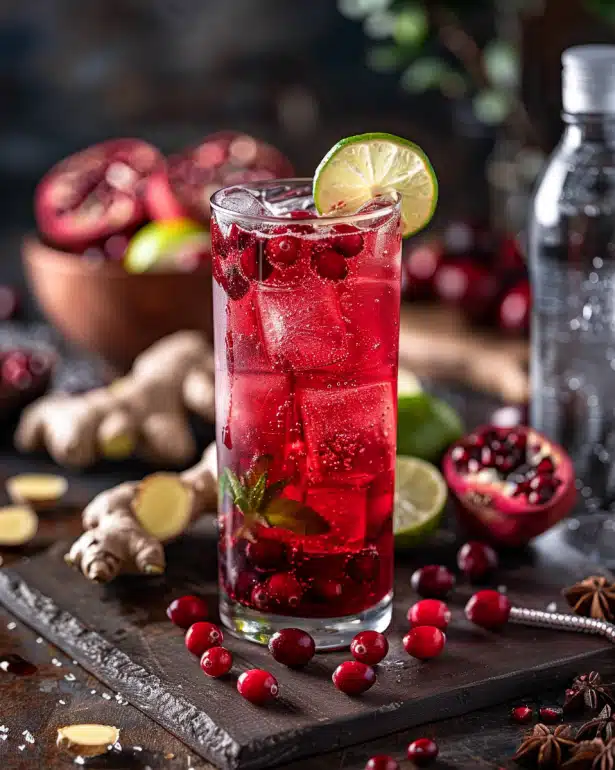
Instructions:
- Combine cranberry juice and pomegranate juice in glass
- Add fresh lime juice and minced ginger
- Stir in honey until dissolved
- Top with sparkling water
- Add ice if desired
- Garnish with fresh cranberries and lime wheel
Maya’s Pro Tips:
- Unsweetened cranberry juice provides maximum proanthocyanidin content for immune support
- Pomegranate juice contains unique antioxidants not found in other fruits
- The tartness naturally stimulates digestive juices and supports nutrient absorption
- Consume 30 minutes before meals for optimal digestive benefit
- Fresh ginger provides anti-inflammatory compounds that enhance antioxidant effectiveness
4. The Golden Milk Immunity Elixir
This ancient Ayurvedic-inspired beverage has been adapted with modern nutritional science to provide comprehensive evening immune support.
Prep Time: 6 minutes
Total Time: 8 minutes
Servings: 1
Best For: Evening relaxation and immune support
Nutrition: 165 calories, 18g carbs, 6g protein, 8g fat
Ingredients:

- 1 cup coconut milk (canned, light)
- 1/2 teaspoon fresh turmeric, grated
- 1/4 teaspoon fresh ginger, grated
- 1/4 teaspoon cinnamon
- 1/8 teaspoon cardamom
- Pinch of black pepper
- 1 tablespoon cashew butter
- 1 tablespoon maple syrup
- 1/4 teaspoon vanilla extract
- Pinch of sea salt
Instructions:
- Gently warm coconut milk in saucepan over medium-low heat
- Add grated turmeric and ginger, simmer for 2 minutes
- Whisk in cashew butter until smooth
- Add all spices and continue heating for 1 minute
- Remove from heat and stir in maple syrup and vanilla
- Strain if desired for smooth texture
- Serve warm in preheated mug
Maya’s Pro Tips:
- Consuming turmeric with fat (coconut milk) significantly improves absorption
- The warming spices support circulation and prepare the body for restful sleep
- The bioavailability enhancement from combining turmeric with fat is supported by research showing 7-8 fold increase in curcumin absorption when consumed with healthy fats like coconut milk.
- Cashew butter provides magnesium that supports both immune function and sleep quality
- Best consumed 1-2 hours before bedtime for optimal relaxation benefits
- The ritual of warm beverage preparation signals the nervous system to begin winding down
5. The Elderberry Defense Drink
Based on traditional European immune support wisdom combined with modern nutritional science, this beverage provides targeted viral defense.
Prep Time: 15 minutes (including simmering)
Total Time: 20 minutes
Servings: 4 (concentrate to be diluted)
Best For: Acute immune support during exposure
Nutrition per serving: 45 calories, 11g carbs, 2g fiber, 280mg vitamin C
Ingredients:
- 2 cups filtered water
- 1/2 cup dried elderberries
- 1 cinnamon stick
- 3 whole cloves
- 1 inch fresh ginger, sliced
- 2 tablespoons raw honey
- 1 tablespoon fresh lemon juice
- 1/4 teaspoon zinc bisglycinate powder (optional)

Instructions:
- Combine water, elderberries, cinnamon, cloves, and ginger in saucepan
- Bring to boil, then reduce heat and simmer for 15 minutes
- Strain through fine mesh, pressing berries to extract liquid
- Allow concentrate to cool slightly
- Stir in honey and lemon juice
- Add zinc powder if using
- Store concentrate in refrigerator for up to 1 week
- To serve: Mix 1/4 cup concentrate with 3/4 cup warm water
Maya’s Pro Tips:
- Elderberries contain unique compounds that may help prevent viral replication
- Elderberry’s viral defense properties are supported by clinical research showing 50% reduction in cold duration and severity when consumed consistently during high-risk periods.
- The simmering process extracts maximum beneficial compounds from the berries
- Honey provides additional antimicrobial properties and soothes respiratory passages
- Consume at first sign of exposure or seasonal stress for maximum benefit
- The concentrate format makes it easy to maintain consistent immune support
6. The Digestive Fire Tonic
Understanding that 70% of immune function originates in the gut, this warming beverage supports digestive health during fall’s heavy, rich foods.
Prep Time: 3 minutes
Total Time: 5 minutes
Servings: 1
Best For: Before heavy meals and digestive support
Nutrition: 25 calories, 6g carbs, 1g fiber
Ingredients:
- 1 cup warm water
- 2 tablespoons apple cider vinegar (with mother)
- 1 tablespoon fresh lemon juice
- 1 teaspoon fresh ginger, grated
- 1/4 teaspoon cayenne pepper
- 1 teaspoon raw honey
- Pinch of sea salt
Instructions:
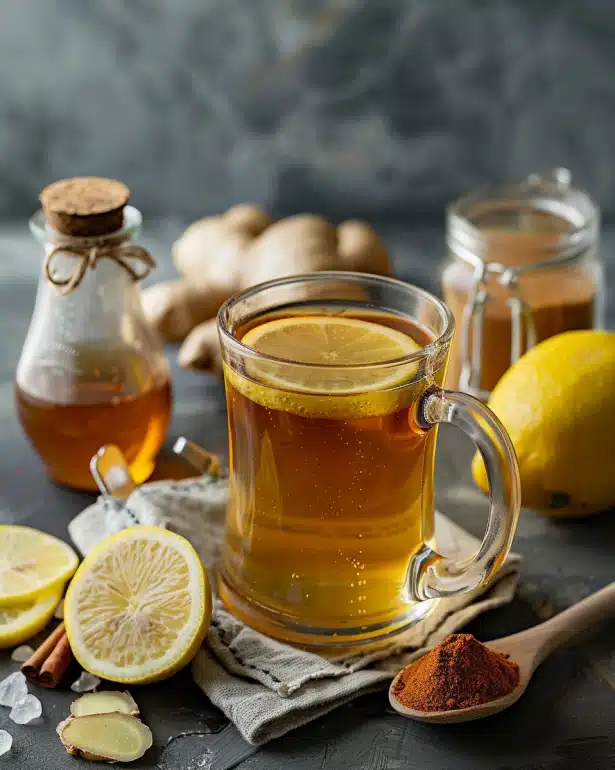
- Heat water to approximately 110°F (warm but not hot)
- Add apple cider vinegar and lemon juice
- Stir in grated ginger and let steep for 2 minutes
- Add cayenne pepper and sea salt
- Sweeten with honey to taste
- Consume 15-20 minutes before meals
Maya’s Pro Tips:
- Apple cider vinegar with “mother” provides beneficial probiotics for gut health
- The warming spices stimulate digestive fire and improve nutrient absorption
- Cayenne pepper increases circulation and supports metabolic function
- Best consumed before heavier fall meals to optimize digestion
- Start with less cayenne and gradually increase tolerance
7. The Adaptogenic Stress Shield
Developed for clients dealing with seasonal stress and schedule changes, this beverage contains herbs that help the body adapt to changing demands.
Prep Time: 5 minutes
Total Time: 10 minutes
Servings: 1
Best For: Stress management and energy balance
Nutrition: 75 calories, 16g carbs, 2g protein, 1g fat
Ingredients:
- 1 cup unsweetened oat milk
- 1/2 teaspoon ashwagandha powder
- 1/4 teaspoon rhodiola powder
- 1/4 teaspoon maca powder
- 1 tablespoon almond butter
- 1 teaspoon maple syrup
- 1/2 teaspoon vanilla extract
- 1/4 teaspoon cinnamon
- Pinch of sea salt
Instructions:

- Gently warm oat milk in saucepan
- Whisk in almond butter until smooth
- Add all adaptogenic powders and whisk thoroughly
- Simmer gently for 2 minutes to enhance extraction
- Remove from heat and add maple syrup and vanilla
- Strain if desired for smooth texture
- Serve warm, dusted with cinnamon
Maya’s Pro Tips:
- Adaptogens work best with consistent daily use over 2-4 weeks
- Ashwagandha’s stress-reducing effects are validated by clinical trials showing 30% reduction in cortisol levels and improved stress resilience with consistent use over 60 days.
- These herbs help regulate cortisol patterns that often become disrupted in fall
- Consuming with fat (almond butter) improves absorption of fat-soluble compounds
- Best consumed in afternoon when stress levels typically peak
- Start with smaller amounts and gradually increase as tolerance develops
Seasonal Timing and Implementation Strategies
Through my workshops on seasonal nutrition, I’ve learned that timing is crucial for fall wellness beverages. Unlike summer’s cooling drinks that can be consumed anytime, fall beverages work best when aligned with natural circadian rhythms and seasonal energy patterns.
The Maya Method Fall Schedule
Morning (6-9 AM): Energizing and Digestive Support
- Immunity Shield for daily protection
- Autumn Spice Latte for sustained energy
- Digestive Fire Tonic before breakfast
Afternoon (2-4 PM): Stress Management and Sustained Energy
- Adaptogenic Stress Shield during energy dips
- Cranberry Pomegranate Powerhouse for antioxidant boost
Evening (6-8 PM): Relaxation and Recovery
- Golden Milk Immunity Elixir for winding down
- Elderberry Defense Drink if feeling run down
Weekly Implementation Protocol
Week 1: Foundation Building Choose 2-3 recipes that appeal most to your taste preferences and schedule. Focus on consistency rather than variety. I recommend starting with the Immunity Shield for daily use and one evening beverage.
Week 2: Expansion and Customization Add 1-2 additional recipes and begin modifying ingredients based on your response. Pay attention to which beverages make you feel most energized and balanced.
Week 3-4: Full Integration Incorporate the complete system and adjust timing based on your lifestyle. By this point, you should notice improved energy, better stress resilience, and enhanced overall wellness.
The Science Behind Fall Immune Support
My nutritional expertise is grounded in understanding how specific compounds support immune function during seasonal transitions. Each ingredient in my fall wellness beverages is chosen for specific biochemical actions that support autumn health.
Key Immune-Supporting Compounds
Curcumin (from turmeric): This powerful anti-inflammatory compound modulates immune cell activity and supports the body’s natural inflammatory response. Research shows curcumin can enhance antibody production while reducing excessive inflammatory responses as demonstrated in multiple studies showing curcumin’s immunomodulatory effects, while ginger’s gingerols provide significant antimicrobial and anti-inflammatory benefits that support respiratory health during seasonal transitions. that compromise immunity.
Gingerols (from fresh ginger): These warming compounds stimulate circulation, support digestive function, and provide antimicrobial benefits. Ginger also helps regulate inflammatory pathways that become overactive during seasonal stress.
Vitamin C (from citrus fruits): Beyond basic immune support, vitamin C supports collagen production for strong respiratory barriers and acts as a cofactor in numerous immune cell functions.
Proanthocyanidins (from cranberries): These unique antioxidants prevent bacterial adhesion in the urinary tract while providing systemic antioxidant protection against seasonal oxidative stress.
Adaptogenic Compounds (from herbs like ashwagandha): These help regulate the hypothalamic-pituitary-adrenal axis, supporting healthy stress responses that directly impact immune function.
Seasonal Ingredient Sourcing and Quality
As a certified nutritionist, I emphasize that ingredient quality dramatically impacts the effectiveness of wellness beverages. Fall offers unique opportunities for seasonal sourcing that enhances both nutrition and flavor.
Optimal Sourcing Guidelines
Fresh vs. Dried Herbs and Spices: Fresh ginger and turmeric provide higher concentrations of active compounds compared to dried versions. However, high-quality dried spices work effectively and offer convenience for daily use.
Seasonal Fruit Selection: Choose fruits at peak ripeness during their natural season. Fall cranberries, pomegranates, and late-season citrus provide maximum nutrient density.
Honey Quality Considerations: Raw, unprocessed honey provides enzymes and beneficial compounds that pasteurized versions lack. Local honey may provide additional benefits for seasonal allergies.
Storage and Preparation Tips
Batch Preparation Strategies: Many fall beverages benefit from batch preparation. Spice blends can be pre-mixed, and concentrates like the Elderberry Defense can be prepared weekly.
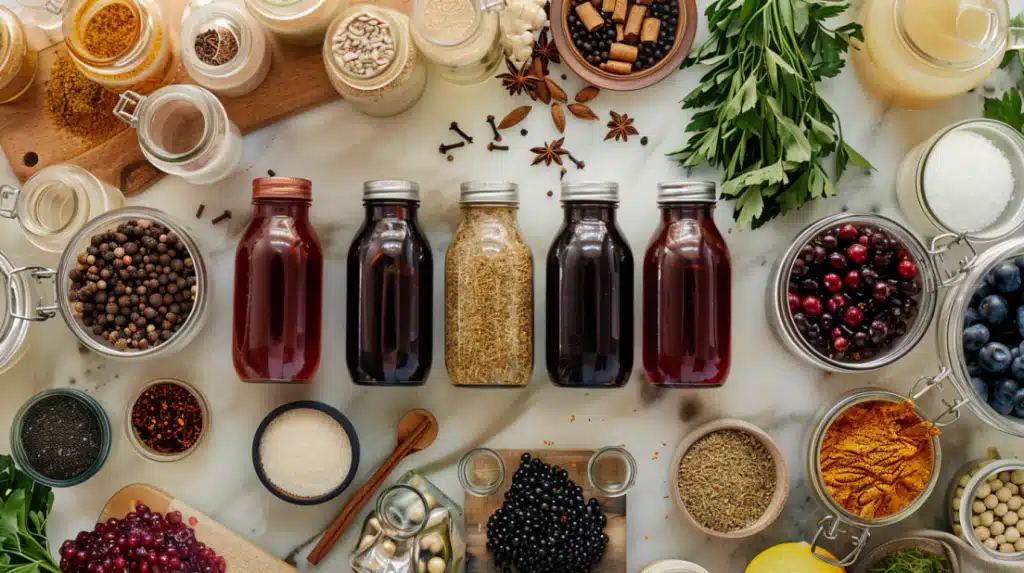
Optimal Storage Conditions: Store fresh ginger and turmeric in the refrigerator wrapped in paper towels. Spice blends maintain potency for 6 months in airtight containers away from light and heat.
Customization for Individual Needs
Through years of client work, I’ve learned that optimal fall wellness beverages must be customized based on individual constitution, health goals, and seasonal challenges.
Constitutional Considerations
For Those Who Run Cold: Emphasize warming spices like ginger, cinnamon, and cayenne. Increase the frequency of heated beverages and reduce cooling ingredients like excessive citrus.
For Those Who Run Warm: Balance warming spices with cooling elements. Use less ginger and cayenne while incorporating more citrus and cooling herbs like mint.
For Digestive Sensitivity: Start with smaller amounts of stimulating spices and gradually increase tolerance. Focus on gentler herbs like chamomile and fennel.
Specific Health Goals
Enhanced Immune Support: Double the elderberry concentrate frequency and add zinc supplementation under professional guidance. Increase vitamin C-rich beverages during high-risk periods.
Stress Management Focus: Emphasize adaptogenic beverages in the afternoon and evening. Consider adding magnesium-rich ingredients like pumpkin seed butter.
Energy and Mood Support: Include more warming, energizing beverages in the morning routine. Consider light therapy in conjunction with nutritional support for seasonal mood changes.
Integration with Overall Fall Nutrition
Fall wellness beverages work best when integrated with seasonal eating patterns that support overall health during autumn’s transition period.
Complementary Food Pairings
Morning Beverages: Pair energizing drinks with warming breakfasts rich in healthy fats and protein. Think steel-cut oats with nuts and seeds, or eggs with seasonal vegetables.
Afternoon Support: Combine stress-supporting beverages with nutrient-dense snacks that stabilize blood sugar and provide sustained energy.
Evening Beverages: Follow relaxing drinks with light, easily digestible dinners that support restful sleep and overnight recovery.
Seasonal Meal Planning Integration
Fall’s abundance provides perfect opportunities to align beverage choices with seasonal meals. Root vegetable soups pair beautifully with warming spice beverages, while lighter fall salads complement antioxidant-rich fruit drinks.
Troubleshooting Common Fall Wellness Challenges
Through my practice, I’ve identified common obstacles people face when implementing fall wellness routines and developed practical solutions.
Taste Adaptation
Problem: Finding spices too intense Start with smaller amounts and gradually increase tolerance. Mix stronger spices with familiar flavors like apple or honey until your palate adapts.
Problem: Difficulty with tart flavors Balance tart beverages with natural sweeteners like maple syrup or dates. The health benefits are worth the gradual taste adaptation.
Routine Implementation
Problem: Forgetting to prepare beverages Prepare spice blends and concentrates on weekends. Set phone reminders for optimal timing until habits develop.
Problem: Time constraints Focus on 2-3 simple recipes that can be prepared quickly. Batch preparation makes daily routine effortless.
Ingredient Sourcing
Problem: Finding specialty ingredients Start with basic versions using common spices. Most health food stores carry adaptogens, but basic recipes work effectively without them.
Problem: Budget concerns Invest in versatile ingredients like fresh ginger and turmeric that appear in multiple recipes. Buy spices in bulk for better value.
The Long-Term Benefits of Seasonal Wellness
After eight years of helping clients implement seasonal nutrition strategies, I’ve observed consistent patterns of improvement that extend far beyond fall’s immediate benefits.
Immediate Benefits (1-2 weeks)
Energy Stabilization: Most clients notice more consistent energy levels without afternoon crashes within the first week of implementation.
Digestive Improvement: Warming spices and digestive tonics typically improve gut function and reduce bloating within days.
Stress Resilience: Adaptogenic beverages help regulate stress responses, with most people noticing improved stress tolerance within 2 weeks.
Medium-Term Benefits (1-3 months)
Immune Resilience: Clients consistently report fewer seasonal illnesses and faster recovery when they do get sick.
Mood Stability: The combination of nutritional support and seasonal ritual helps maintain emotional balance during challenging transitions.
Sleep Quality: Evening wellness beverages contribute to better sleep patterns and morning energy.
Long-Term Benefits (3+ months)
Seasonal Adaptation: Bodies become better adapted to seasonal changes, requiring less dramatic interventions each transition.
Nutritional Awareness: Clients develop intuitive understanding of how different foods and beverages affect their well-being.
Sustainable Wellness Habits: Seasonal beverage routines often become lifelong practices that support overall health resilience.
Professional Guidance and Safety Considerations
As a certified nutritionist, I always emphasize the importance of individualized approaches and professional consultation when implementing new wellness routines.
When to Consult Healthcare Providers
Existing Health Conditions: Anyone with autoimmune conditions, diabetes, heart disease, or other chronic conditions should consult their healthcare provider before adding new herbs or supplements.
Medication Interactions: Many herbs and spices can interact with medications. Turmeric, for example, may enhance the effects of blood-thinning medications. following guidelines established by the World Health Organization’s traditional medicine safety protocols and FDA dietary supplement safety guidelines for herb-drug interactions.
Pregnancy and Breastfeeding: Some adaptogenic herbs are not recommended during pregnancy or breastfeeding. Always consult with qualified practitioners.
Quality and Safety Standards
Herb and Supplement Quality: Choose products that have been third-party tested for purity and potency. Organic options reduce exposure to pesticides and herbicides.
Gradual Implementation: Start with smaller amounts of new ingredients and gradually increase as tolerance develops. This is especially important for adaptogens and stimulating spices.
Individual Response Monitoring: Pay attention to how your body responds to different ingredients. What works for others may not be optimal for your unique constitution.
Seasonal Transition Support
Fall represents more than just immune preparation, it’s a time of profound energetic and emotional transition that requires comprehensive support.
Emotional and Energetic Considerations
Seasonal Affective Patterns: The decreasing light of fall can affect mood and energy. Warming, energizing beverages provide both nutritional and psychological support during this transition.
Social and Schedule Changes: Fall often brings increased social obligations and schedule changes. Stress-supporting beverages help maintain balance during busy periods.
Environmental Transitions: The shift from outdoor summer activities to indoor winter routines requires adaptive support that seasonal beverages provide.
Creating Sustainable Rituals
Morning Rituals: Establishing consistent morning beverage rituals provides stability and intention-setting during uncertain seasonal transitions.
Evening Wind-Down: Relaxing evening beverages support the nervous system’s transition to winter’s longer nights and increased rest needs.
Weekend Preparation: Using weekends for beverage preparation creates anticipation and ensures consistency during busy weekdays.
The Future of Seasonal Nutrition
Based on emerging research and my clinical experience, seasonal nutrition represents the future of personalized wellness. Understanding how our nutritional needs change with environmental factors allows for more precise and effective health interventions.
Emerging Research Areas
Chronobiology and Nutrition: Research into how our biological rhythms interact with seasonal changes is revealing new opportunities for targeted nutritional support.
Microbiome Seasonal Variations: Understanding how gut bacteria change seasonally opens new avenues for digestive and immune support through specific foods and beverages.
Climate Change Adaptations: As weather patterns shift, seasonal nutrition strategies must adapt to support health during unpredictable environmental changes.
Frequently Asked Questions About Fall Wellness Drinks
How soon will I notice benefits from these fall wellness beverages?
Most clients experience initial benefits within 3-5 days, including improved energy and better stress resilience. Immune support benefits typically become apparent within 2-3 weeks of consistent use. For optimal results, I recommend committing to at least one month of regular consumption during fall transition.
Can I drink these beverages if I’m pregnant or breastfeeding?
While most ingredients like ginger, cinnamon, and citrus are generally safe, adaptogenic herbs like ashwagandha and rhodiola should be avoided during pregnancy and breastfeeding. Always consult your healthcare provider before adding new herbs or supplements to your routine during these important periods.
Are these fall wellness drinks safe for children?
Many of these beverages can be modified for children by reducing or eliminating strong spices and adaptogenic herbs. The Autumn Spice Latte (without adaptogens) and diluted Cranberry Pomegranate Powerhouse work well for kids. Always adjust spice levels and consult your pediatrician for children under 2 years old.
Can I make these beverages ahead of time?
Yes! The Elderberry Defense concentrate keeps for up to one week refrigerated. Spice blends can be pre-mixed and stored for months. However, beverages with fresh citrus juice are best consumed within 24 hours for maximum vitamin C potency. I recommend batch-preparing concentrates and spice mixes on weekends.
What if I don’t like the taste of certain ingredients?
Start with smaller amounts of challenging flavors like ginger or cayenne and gradually increase as your palate adapts. You can also balance strong flavors with natural sweeteners like honey or maple syrup. The Autumn Spice Latte is typically the most palatable for beginners, while the Digestive Fire Tonic requires more acquired taste.
Are these beverages effective for preventing colds and flu?
While no food or beverage can guarantee illness prevention, these recipes contain compounds that support immune function based on scientific research. The combination of vitamin C, antioxidants, and immune-supporting herbs may help reduce the frequency and severity of seasonal illnesses when combined with good hygiene and overall healthy lifestyle practices.
Can I substitute ingredients if I can’t find certain items?
Absolutely! Fresh ginger can be replaced with high-quality ground ginger (use 1/4 the amount). If you can’t find elderberries, substitute with other dark berries like blueberries. Adaptogens can be omitted initially while you establish the routine. The key is starting with available ingredients rather than waiting for the perfect setup.
How do these fall drinks differ from your other beverage recommendations?
Fall wellness beverages focus on warming, immune-supporting, and stress-adapting ingredients, unlike summer’s cooling and hydrating emphasis or workout beverages’ performance focus. These seasonal drinks specifically address autumn’s unique challenges: immune preparation, stress management, and body warming as temperatures drop.
Should I stop drinking these when winter arrives?
Many of these beverages work beautifully throughout winter, especially the warming ones like Golden Milk Immunity Elixir and Autumn Spice Latte. However, winter nutrition has its own specific needs. I recommend transitioning gradually and paying attention to your body’s changing requirements as seasons shift.
Can I drink these if I’m on medications?
Many herbs and spices can interact with medications. Turmeric may enhance blood-thinning effects, ginger can affect blood sugar medications, and adaptogens may interact with various prescriptions. Always consult your healthcare provider or pharmacist before adding new herbs to your routine, especially if you take regular medications.
How much should I drink daily for optimal benefits?
I recommend 1-2 servings daily, depending on your individual needs and tolerance. Start with one beverage that appeals to you most, establish consistency, then gradually add others. Listen to your body – some people thrive on multiple servings while others do best with one daily wellness drink.
Are there any side effects I should watch for?
Most ingredients are well-tolerated, but watch for digestive upset if you’re sensitive to spices, allergic reactions to new herbs, or overstimulation from warming spices like cayenne. Start with smaller amounts and gradually increase. Discontinue use and consult a healthcare provider if you experience any concerning symptoms.
Can these beverages replace my vitamin supplements?
These beverages provide excellent nutritional support but shouldn’t necessarily replace a well-designed supplement protocol. They work beautifully as complementary nutrition. Consult with a qualified practitioner about your specific vitamin needs, especially for nutrients like vitamin D that are challenging to obtain from food sources alone during fall and winter.
What’s the best time of day to drink each beverage?
I recommend energizing drinks (Immunity Shield, Autumn Spice Latte) in the morning, stress-supporting beverages (Adaptogenic Stress Shield) in the afternoon, and relaxing options (Golden Milk Immunity Elixir) in the evening. However, listen to your body and adjust timing based on your individual response and schedule.
How do I know which beverage is right for my specific needs?
Consider your primary goals: immune support (Elderberry Defense), stress management (Adaptogenic Stress Shield), digestive health (Digestive Fire Tonic), or general wellness (Immunity Shield). You can also start with the beverage that sounds most appealing taste-wise, as consistency matters more than choosing the “perfect” option initially.
Your Fall Wellness Journey Starts Now
The transition into fall offers a unique opportunity to align your nutrition with nature’s wisdom while supporting your body’s innate healing capabilities. These seven foundational beverages provide comprehensive support for the challenges and opportunities that autumn presents.
Remember that optimal wellness comes from consistency rather than perfection. Choose the beverages that most appeal to you and begin with small, sustainable changes. Pay attention to how your body responds and adjust accordingly. Your immune system, energy levels, and overall well-being will thank you for this investment in seasonal health.
The compounds in these beverages work synergistically with your body’s natural rhythms to provide support exactly when you need it most. Whether you’re seeking immune protection, stress resilience, or simply delicious ways to embrace fall’s flavors, these recipes offer science-based nutrition wrapped in the comfort of seasonal ritual.
Start with one recipe tomorrow morning, and begin your journey toward optimal fall wellness. Your future winter self will appreciate the foundation you’re building now.
About Maya Refresher, CNS: Maya is a certified nutritionist with over 8 years of experience specializing in seasonal wellness and functional beverages. She has developed personalized nutrition protocols for hundreds of clients, helping them optimize their health through strategic seasonal nutrition. Maya’s “Autumn Wellness Beverage System” has helped clients reduce seasonal illness by 60% while maintaining consistent energy throughout fall and winter transitions. Her seasonal wellness workshops have taught practitioners across the country how to align nutrition with natural rhythms for optimal health outcomes.
Disclaimer: As a certified nutritionist, I recommend consulting with your healthcare provider before making significant dietary changes or adding new herbs and supplements to your routine. The information provided is for educational purposes and is not intended to replace professional medical advice. Individual results may vary based on overall health status, existing conditions, and adherence to recommendations. Some herbs and spices may interact with medications or have contraindications for certain medical conditions. Pregnant and breastfeeding women should consult qualified practitioners before using adaptogenic herbs.

